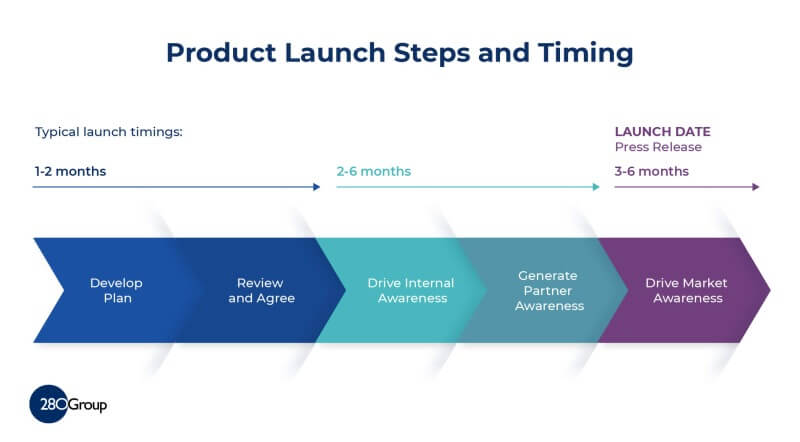Building and launching a software product can feel like a constant exercise in planning ahead, executing in the moment, and putting out fires before, during, and after. In the midst of a dozen competing priorities, one of the most critical milestones is the software product launch. No matter how amazing your software product is, the company will not be successful unless people can find it and have a satisfying experience using it.
The other inconvenient truth for software development teams and managers is that a successful software product launch does not magically march forth from the marketing silo. Planning for the product launch should be tied to the overall software development roadmap.
The good news is, even though software product launching may not feel like it has much in common with software development, the process of planning a launch is actually very milestone-oriented and should feel somewhat familiar in that way.
One way to make it easier and more intuitive is to plan the software product launch in phases and reverse engineer the experience and desired outcome.
The obvious answer is our desired outcome is we want lots of sales, fat revenue, and happy customers who flood their Reddit and Twitter streams with glowing testimonials. Getting to that result requires some pre-launch planning outside of product development milestones. So as hard as it may be to find the time, successful software product launching requires careful planning that overlaps with the development roadmap, too.
Just like in software development planning, it is helpful to look at the big picture first. The image below shows what launching looks like from the 10,000-foot level, or, the hindsight view, if you put in the work ahead of time.

Let’s break down an overview.
Beta Launching a Software Product
The truth is, any plan that tries to predict people’s reactions will have blind spots. In the late 1800s, a Prussian military strategist wrote that no plan survives first contact with the enemy. Consumer product developers have known for decades that customers are unpredictable. They use focus groups and surveys to try to glean insights into customer opinions and reactions.
Surveys and opinion polls after the fact present at least two challenges. The first is timing. If you collect opinions and data based on the finished product, it's hard to go back and make changes.
Secondly, it is an objective fact that some people lie. They may not even consciously do so, but asking people about what they might do in a certain situation gives you very different feedback than observing what they actually do in that same situation.
The inability to predict customer behavior is at the heart of lean or agile development. Instead of springing a full-blow product with untested assumptions baked into it on an unsuspecting customer group, lean development recommends an iterative approach.
This is one reason many software teams create a soft launch of a beta product that is functional enough for people to get some results, but not so perfect that it would eat up resources to go back and adjust it. For example, it's likely you already know there are some parts of the software product that are stronger than others. Those weaker areas are where feedback from beta customers will help create a stronger final version.
Using feedback from the beta launch, teams can work out, on a smaller scale, everything from small bugs to glaring omissions. This saves resources by optimizing the product for the “hard” launch to go more smoothly.
The other advantage to a beta launch is in giving sales and marketing a chance to test out their communications in a less pressured environment, too. Beta launch conversations and sales data can lead to a more efficient sales funnel for upcoming launches.
Communication is Key for Software Product Launch
Software product launching involves several stakeholders - internal teams, external partners, and marketing channels. Especially in these times of information overload, everyone involved does not need to know everything all at the same time.
While it's important to keep people informed of the bigger picture, avoid burdening busy people with details that don’t help them execute their part of the launch. The basic tools for this are a timeline and clear channels of communication.
The five main phases of a software product launch are initial planning, pre-launch, sales, and channel partner launch, launch day (or week), and post-launch review. Establish clear channels upfront about how and when the launch team will communicate during each stage.
Baseline information is critical. Create a resource document that includes the objective of the launch, key players, and an overview timeline. Each team should have one designated “point-person” who is the main contact for the launch team. Don’t forget to schedule regular check-ins with the launch support executive team, too.
Arm Your Software Product Sales and Marketing Team
A well-prepared, confident sales and marketing team is a juggernaut for any software product launch. The goal is to get them excited, not just informed, about the software product. Their energy can contribute a positive ripple effect to a launch, and even compensate for some other areas that may not go as smoothly. Be sure to equip them with the basics:
- Create thorough software product information for internal teams.
- Work together to “translate” software product features and benefits into words the target customer understands and relates to, avoiding jargon.
- Include comparison information between similar and competitor software products.
- Document what problem the software product solves, from as many different perspectives as possible.
- Be sure to give the sales team a heads up about any weak spots so that they can anticipate and form responses to those objections.
Strategically Celebrate Product Launches
Who hasn’t watched at least a few minutes of one of Apple’s iconic product launches from the Steve Jobs era? Better yet, raise your hand if you ever stood in line outside an Apple store on the release day of a highly anticipated product. Well, maybe not - that level of fervor has faded, but you can learn from those examples for your software product launch.
At the end of the day, customers are human beings and humans operate on an emotional level most of the time. Our subconscious emotional affiliations can have a big impact on purchasing decisions, too.
Events can be a great way to celebrate and raise awareness of a software product launch. Don’t treat the event like an after-party attached to the press release, though. Apple and other successful companies integrate their launch events into their overall strategic plan. They also pay careful attention to what their audience might find compelling.
While the marketing team or consultants will take the lead in planning a launch event, software product development folks are important, especially if the target audience includes a segment of technical people who will want to learn more.
Balance Software Product Launch Momentum and Retention
Have you ever planned a big event, only to feel deflated or even a little down afterward? Have you ever attended a rah-rah inspirational conference with great “mountain top” moments, only to feel back to square one a couple of weeks after returning home?
Those are both examples of how you don’t want your team and customers to feel after your launch. So what is the answer?
A successful software product launch builds momentum. Of course, you can’t sustain the launch momentum forever, that’s why it's called a launch, right? The key is you want to retain some of that new energy going forward.
Momentum requires more effort at the beginning, starting from a dead stop. After it kicks in, it requires less energy to keep going. To preserve momentum and resources, the software launch team should plan some post-launch activities to remain visible, especially if they are working on a beta launch leading up to a bigger launch in the future.
On the flip side, the whole purpose of a software launch is to garner new customers. Development teams need to strike a balance between keeping those customers happy (ie retaining them) vs. acquiring more while also planning for the next software product launch.
Moving Ahead
While software product launching may seem like a distraction for a development team, it actually represents many opportunities for product improvement, sales momentum, and building internal team and strategic partner relationships.
Start early, start with the end in mind, and create a clear path based on desired outcomes to prepare your team for success. Sharkbyte has years of experience helping teams factor in software product launches as part of their overall software development roadmap planning. Contact us today for a free consultation!
Starter Checklist for Software Product Launch Communciation
- Create a one-sheet baseline document with launch objective, timeline and key players
- Establish internal and external communication channels
- Create thorough product information for internal teams
- Create customer-facing, non-jargony descriptions of features and benefits
- Asses competition with comparison information between similar and competitor software products
- Document “What problem do we solve?” (Not just what does the product “do”.)
- Document red flags and known issues so the sales team can form responses to objections



